The Homesteaders Handbook: Raising Chickens Part 3
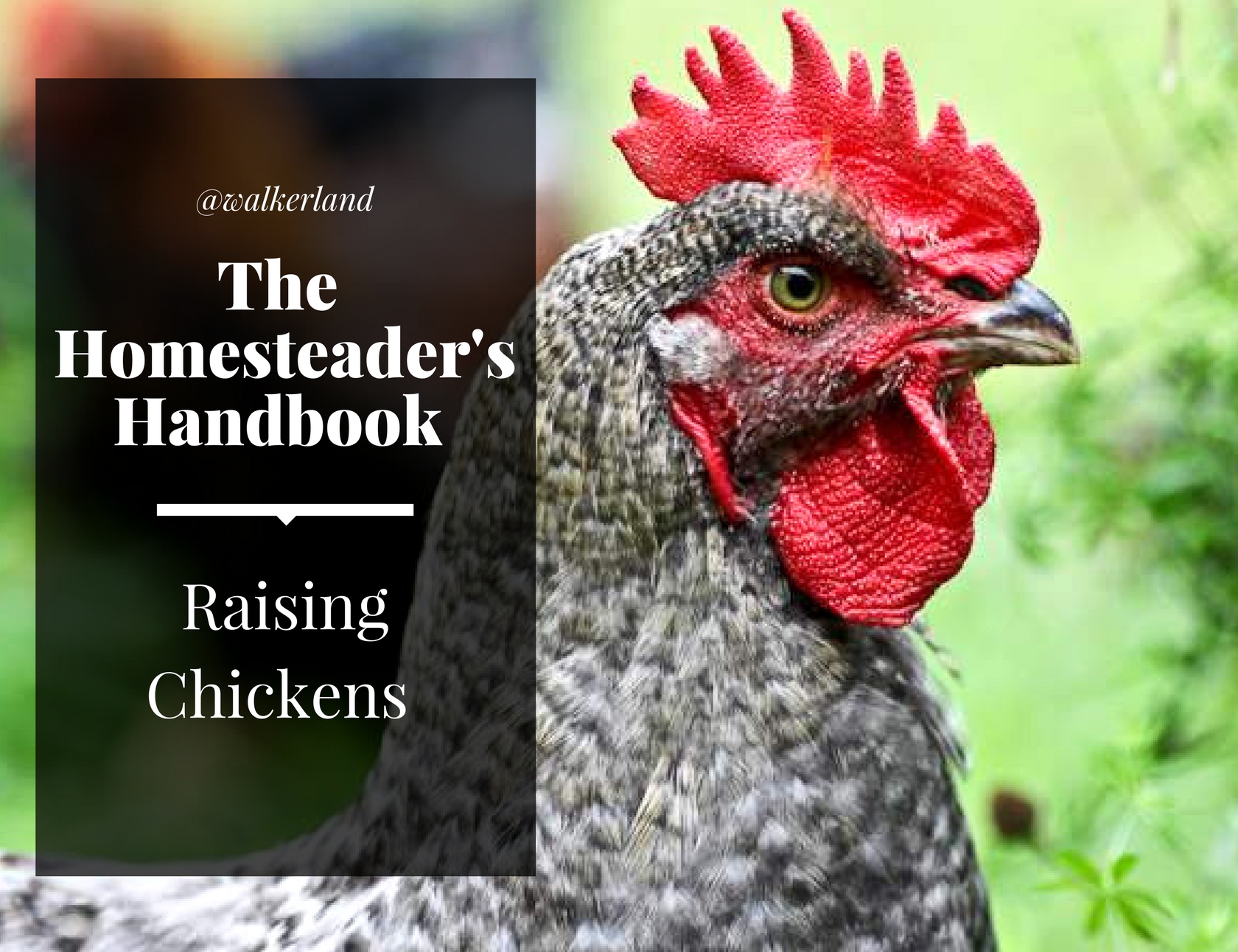.jpg)
This is the third part in a complete series on raising chickens! In this chapter we'll talk about chicken coops, shelter, tractors, pastures and keeping your chickens safe from predators.
You can find earlier chapters in this series here
The Homesteaders Handbook: Raising Chickens Part 2 - Breeds, hybrid vs heritage and more
One thing I like to talk about before describing our chicken coop is the natural order of things. Always keep in mind that the most time your chickens spend outdoors the better. Being in enclosed spaces for long periods provides a breeding ground for germs and illnesses.
In a lot of environments chickens will be happiest and healthiest when choosing their own form of shelter. I am not saying you should do this but you should be aware that chickens are resourceful and they are much tougher and far more adaptable than we give them credit for. They don't need anything fancy. They don't need heat or lights to be comfortable. As long as they have protection from the elements, food and water, they don't really need much from us.
The type of shelter you will need really depends on your environment. We live in a cooler climate with a lot of snow so a coop is our best choice for year round convenience.
Chicken Coops
A coop is generally the best solution when keeping chickens year round. It is designed to make our lives easier by encouraging certain predictable behaviours such as laying eggs where you can find them and having your chickens returning to the same spot each night. It also protects the chickens from night-time predators and with just about everything liking the taste of chicken it is quite important. That said, I've seen pictures of Volkswagen-based chicken coops and the chickens seemed happy as punch!
There are a lot of variables to consider when designing your coop and run. Your environment, climate, budget, resources, space and so on. I will describe the basic necessities of a chicken coop and run but you will need to adapt your own design to your own requirements, resources & creativity.
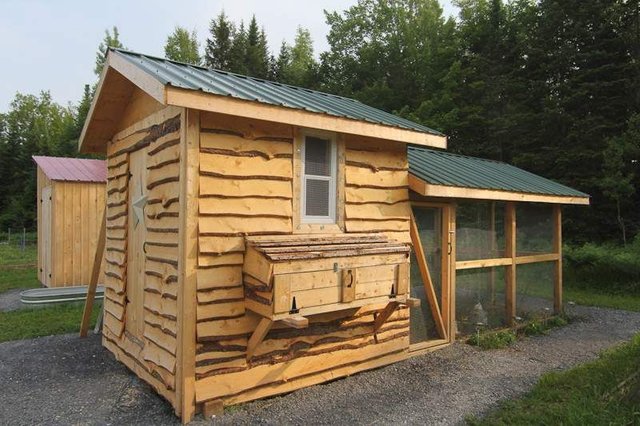
Coop Sizing
You will want to allow for roughly 4 SQ FT per bird in the chicken coop plus outdoor space in a run or fenced area. The height of a coop does not factor into this calculation, only the floor space. Do yourself a favour and don't overcrowd your chickens. Unhappy birds fight and get up to no good.
We have our coop elevated off the ground. This ensures that it is not sitting in water and in the winter when we have snow storms we can still easily get into the coop.

Ventilation
Ventilation is crucially important for the health and prevention of illness in your flock. If possible your coop should be built tall. You don't want ventilation at the same level that the chickens roost. You want it placed up high, close to the ceiling. This allows air to circulate while avoiding uncomfortable drafts. Ventilation helps moisture to escape, keeps the coop dry and ensures that the air in the coop is kept fresh.
Windows
If possible your coop design should provide plenty of natural light. You can also use some clear panels in the ceiling to create a small skylight. This roof paneling comes in the same format as metal roofing and it's a great way to add light without the expense of a window.

Perches
You will need perches so your chickens can roost at night. A lot of perches are made small and round but these are actually more difficult for Chickens to hang onto. A wider flat surface is more idea. 2x4's with the wider 4”side of the board laid flat are the perfect width for perches. If you are building more than one perch make sure that one is lower than the other and they are about 2FT apart. You don't want the birds on the upper perch to poop on the birds below them. If you can, make the perches removable so that you can easily access the area beneath the perch for a good cleaning, several times per year. A little building ingenuity will save you work down the line (as with anything on the homestead!)
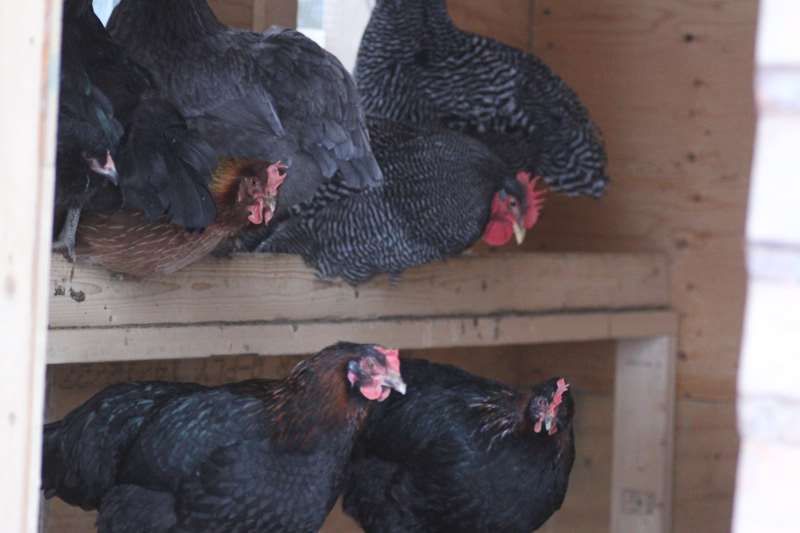
Dropping Board
Beneath the perch is where the majority of the mess will be in the coop. The wall nearest to the perch will also be splattered with droppings as well. Installing a removable dropping board which can be as simple as plywood with some old vinyl flooring attached makes regular cleaning of this area of the coop lot easier to manage. I like to use a snow shovel that has a metal scraping edge and do a quick scoop out of this area every few days. It keeps odors at bay in between the bigger cleanings. I Just scoop it up and toss it into the compost pile. If you wanted to get fancy, this is where you would plumb your chicken sewer drain: beneath the perch.
Coop Flooring
If your coop has a wooden floor it should be covered with laminate flooring or some other non absorbent material. This will protect the floor and keep it from absorbing urine and other odors. It makes cleaning a lot easier as well. You will then want to lay thick bedding like straw on top of this and change it regularly.
Sheltered Run
In addition to the chicken coop you are probably going to want to build a sheltered run. This is a secure outdoor space that enables the chickens to peck at the earth, exercise and get fresh air. The run usually has a solid weather proof roof. This is immensely useful for dealing with unexpected situations like:
• If you have a predator attack outside and need to keep the hens more confined until it is dealt with
• If there is a Influenza outbreak in your area and you want to lock your hens down for a while
• If you have terrible snow storms coming or you live somewhere that get's mountains of snow in the winter
• If its raining/hailing/sleeting etc
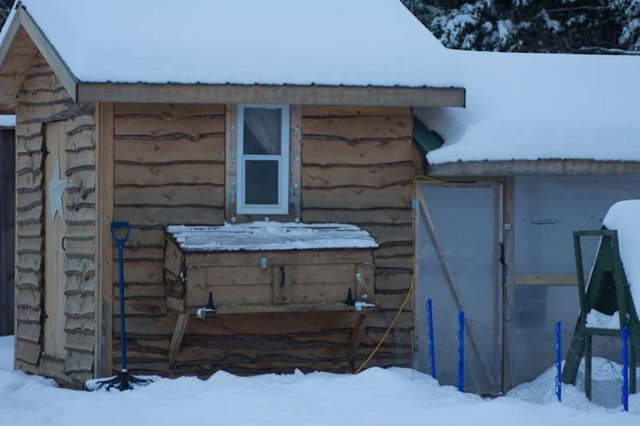
As a rule of thumb you should allow for 10 SQ FT per chicken in the run. The more space you can allow them the better. Overcrowding will cause bickering and pecking which is why the run is so valuable when unexpected situations arise that force you to keep your hens contained. If you plan on keeping your chickens contained to the run/coop indefinitely you might want to increase the size a bit.

The run is typically on bare ground making it very easy to clean. We use a mixture of gravel and sand so that the run has plenty of drainage. It also gives the chickens a chance to scratch and look for bugs. It is important to clean and keep the ground of the run fresh to reduce odors and help prevent parasites and disease.
One really nice thing about having a run with a good roof is that you can staple up sheets of vapor barrier or heavy plastic which will keep out snow through the winter. This provides your chickens with more space even in the worst of weather.
Chicken Tractors & Mobile Pens
Chicken tractors & mobile pens are often shelter/run combos. The idea is that you can continually move the tractor and chickens to fresh pasture while confining the chickens to that area. These can work well for containing chickens to a specific area that you need them to work. They will eat the weeds and bugs and scratch, till and fertilize the ground. They are not ideal year round systems for those of us that live in cold climates or where you get a lot of deep snow.
They are especially useful if you are raising broilers for meat.

Mobile Chicken Coops
Some people have mobile chicken coops that can be moved around with an ATV or tractor. This is a really interesting idea that I personally wish I would have thought of before we built our coop. If you have a large fenced pasture you can section it off with poultry netting and set up a rotational grazing system. The reason I like this so much is that I understand the benefits of our chickens having access to bugs, weeds and other great nutrition that the pasture provides. When the coop is stationary, the ground that the chickens have access to soon becomes a barren waste land with nothing growing on it other than a few things they don't like to eat. Rotational grazing ensures that the ground does not become depleted. We have found a way to counter this with a chicken tunnel that runs to the pasture.
Chicken Tunnels
This is a clever way to provide your chickens with access to an area that is far away from the coop. Trying to Shepard chickens to a certain area can be difficult, or at least in my experiences it never works. They are stubborn and want to go where they want to do unless you trick them and provide them with a well planned and controlled option.
The tunnel is usually designed in one of two ways:
• a tall protected fence leading to a pasture or other protected area. It may have large gates so that it's not blocking you from access to certain parts of your property.
• a movable enclosed shelter similar to a hoop house for your garden. I think a pop up version would be rather handy and I am sure it exists.
If you want to put your chickens to work and your coop is not portable, this is something work considering. In the spring before you plant you can let the chickens raid the greenhouse or your vegetable garden beds, to pick out weeds and till it for you.

Bedding
Sand - In the Spring, Summer and Autumn we use contractor grade sand. This is the gritty sand that has pebbles in it. You don't want to use sandbox sand. It does not work the same way at all! The sand absorbs moisture well and keeps the coop nice and cool. Sand is very economical as well. You can remove the sand from the coop, spread it out on a tarp, wash it really well, bake it in the sun to dry and then add it back to the coop.
Straw - In the Winter we use straw and do the deep litter method. We typically get so much snow that there is nowhere to put the dirty bedding. The method simply requires that every few days you put a fresh layer of straw in the coop. This keeps the coop smelling fresh and the heat from the straw and manure composting adds warmth to the coop.
Pine/wood shavings - You can purchase large bags of shavings from the feed stores or pet stores. It smells great and works really well but with the frequent cleanings required, this is an expensive option. If you have access to a carpenter or contractor you might be able to get a good supply of shavings from them.
Nesting Boxes
A nesting box is a private space for your chicken to lay its eggs. Chickens require privacy to lay their eggs, so you must give them a good spot to do so! You will want to have your nesting boxes in the coop just before the hens start laying eggs: don't give your chickens access to them until they are about to start laying. This will encourage them to lay there rather than developing habits of laying elsewhere, or using the nesting boxes for other purposes.
You want the nesting boxes to be off the ground a bit and it is ideal to cover the opening with a curtain. Hens really like their privacy when laying. You can line the box with straw and if you have some rose petals, lavender or herbs in the garden. A sprinkle of those keeps the boxes smelling nicely.
The chickens tend to keep the nesting boxes quite clean although the odd broken egg will require cleaning. We replace the bedding with fresh straw, every week (less during the winter.)
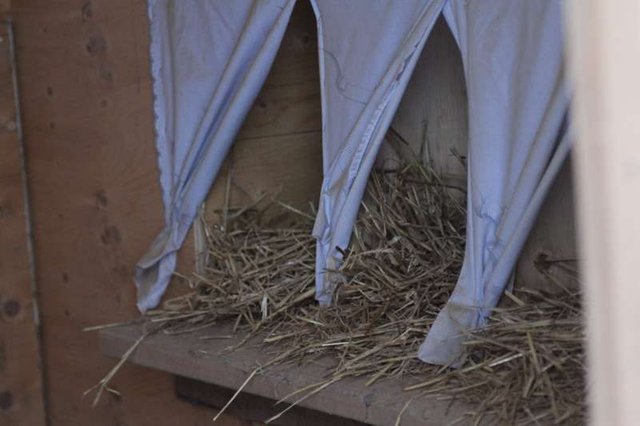
In the next post I'll cover the rest of this chapter including: food and water stations, human health, coop cleanliness, free ranging and more!
This content comes from my Ebook "The Homesteader's Handbook: Raising Chickens". I've decided to give the knowledge away here on steemit where it may help those looking to get into raising chickens. This was always my intention when writing this book.
All rights reserved. Photos copyright @walkerland The information in this book is true and complete to the best of our knowledge. All recommendations are made without guarantee. The author and publisher disclaim any liability in connection with the use of this knowledge.
Building a greener, more beautiful world one seed at a time.
Homesteading | Gardening | Frugal Living | Preserving Food| From Scratch Cooking|
You can also find me at: walkerland.ca
Photo copyright: @walkerland

This is such a great write up, your writing style always draws me in...it flows so nicely. I also love using sand in the coop during warmer months...it makes everything easy to clean. Plus the herbs ❤! Great post, thank you for sharing it.
Thanks so much for the nice feedback, I appreciate it. This took a long time to write, way longer than it should have! Glad you enjoyed it. ❀
I remember growing up how so many people had chickens. Raising chickens is a lost art these days. While not that difficult, it is important to raise them in a clean environment and maintain proper housing. Thanks for the well-written guide. Having chickens would help a lot of struggling people. Too many laws and regulations today.. If people followed this guide, there would be few problems raising chickens, even in the city.
When I was a kid we had two classes of chickens. Layers and yard chickens. Eggs were a cash crop, they were kept in a barn with controlled lighting and heat (sort of). It wasn't like an egg operation today, they had quite a little space and structures. The yard chickens had their own coop that they really only used in the winter. Bantums, they kept the yard and garden and animal pens clean. And they always looked good...
Thanks for sharing, I love reading about how everyone does (or used to) do things. Although we do things a certain way we recognize there are many other ways to do the same thing. Whatever works best for each of us is the best choice right?
I love our nesting boxes. It's tilted a bit so the egg rolls to the front and the kiddos can get to them easily. Great post!
Another thing we did this winter was throw in some ashes from our fireplace. They love to roll in it and it will kill off lice, mites etc, and neutralizes the odor.
The ashes are a great idea and your nesting box sounds really fabulous. Our niece came to visit just when the hens started moulting and weren't laying so I had to sneak out each morning and load up the boxes with eggs so she could discover them. She had to reach way in to get them, so your nesting box design would be more ideal.
Watching her face as she discovered where eggs come from was so precious.
We mix ashes with sand in their dust bath and they love it. One thing about living in a colder climate is that we don't have to worry too much about lice etc in the winter. It's too cold! Ventilation is the most important thing I have to worry about. Making sure there's plenty of air flow but not any cold air on the chickens.
It hasn't gotten too cold this winter. It's so weird.
I just taught a group of prek at co-op about chickens and took our chicks in so they could pet them. They were mortified to know where their food came from lol I was laughing so hard!
oh that is so wonderful. Funny that they were mortified but pretty important knowledge for those young minds! We had an "incident" where one of the kids visiting us saw the egg come out of the chicken. It was the first time I had seen it as well. It was quite interesting but also bad because he didn't want to eat any eggs :)
Hahahaha!
You are a fabulous wealth of information, my friend!
Thank you for so generously sharing your expertise!
Upvoted, resteemed
Wow! Thank you. You are so sweet! ❀
Thank you for all the details in caring for the chickens.. This will defiantly help me as I am looking at getting some and can't wait to use some of your tips with making the home for them as good as I can.. Thank you